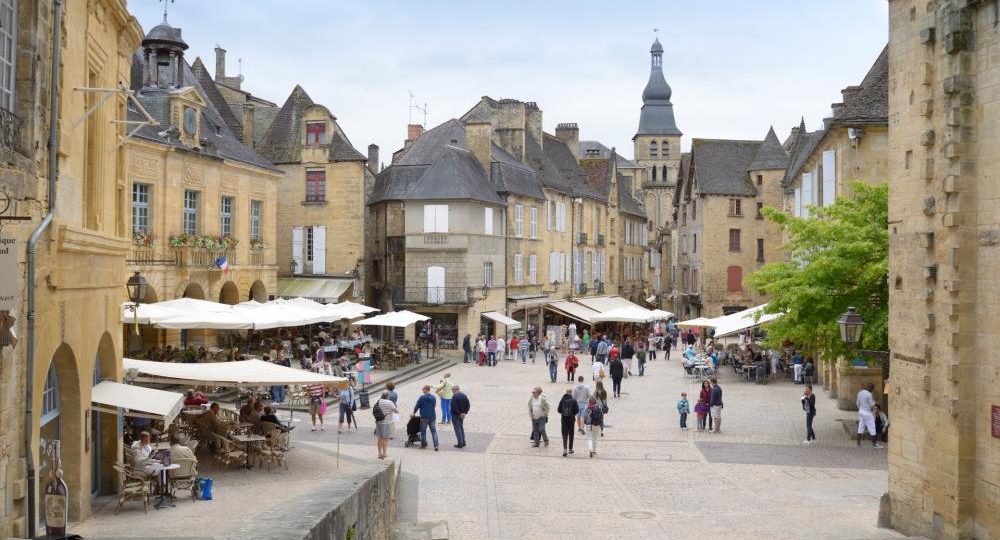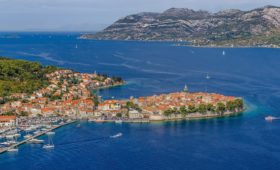Sarlat, France is a fabulous historical place. What can you see in Sarlat and Dordogne area? On the north bank of the Dordogne and a few minutes downstream from Castelnaud-la-Chapelle, is this 12th-century castle built by the Barons of Beynac. Just one look at it and you’ll understand why attackers might have been put off: It’s on a vertical limestone crag, and even now visitors have a hard time getting up there! If you make it you’ll have the pleasure of a 30-minute guided tour which brings the austere romanesque keep to life. The residences added to this monolithic structure include apartments from the 1600s, with carved woodwork and a painted ceiling still intact. See also the Salle des Etats with its renaissance fireplace and the adjoining oratory with walls entirely decorated with frescoes from the 1400s.
Originally an abbey church dating from the 11th century, the Cathedrale St-Sacerdos is a mixture of Romanesque and Gothic styles. The organ in the church is said to be one of the best preserved from the 18th century. Pop inside to hear it being played as part of a special concert or simply soak up the peace and quiet away from Sarlat’s busy squares. Nearby you can spot the a rocket-like structure called ‘lanterne des morts’, a 12th-century stone monument that is said to honour Saint Bernard, who is believed to have cured the sick by blessing their bread.
La Roque-Gageac: Part of the Dordogne’s spell is its drop-dead gorgeous villages, as this waterfront huddle of medieval stone on the Dordogne River testifies. The sheer golden cliffs sheltering a 12th-century troglodyte fort are awe-inspiring. Down on the river, traditional gabarres (barges), used to transport barrels of wine and salt downstream in the 19th century, plough the water. Hop aboard! Or gorge on bird’s eye views of the village and its grey, lauze-tiled rooftops from a hot-air balloon; Montgolfiere du Perigord (montgolfiere-du-perigord.com), a mile up the road, arranges flights.
Searching for Sarlat hotel booking? The origin of the abbey is lost in the legends. It exists since the ninth century, forming part of the six great abbeys of Perigord (Paunat, Belves, Saint Front de Perigueux, Brantome, Terrasson). The Carolingian Abbey of Sarlat is the only one that was saved from the Vikings, located away from the Dordogne River and its tributaries. It was able to remain independent and, in the year 1153, was put under the direct protection of the Holy See in Rome. In the year 1317, the abbey was the seat of the new bishopric created by Pope John XXII. The abbey church was transformed into the cathedral of the diocese of Sarlat. From there began the architectural transformation of the city with the construction of a parish church as well as numerous manors. From the fourteenth century on, bishops and consuls shared power until the Revolution. Sarlat played an important role during the Hundred Years’ War with its status as an episcopal city. The town became a reserve for men of arms, ammunition and provisions. The city was fortified, but it was also defended by the castles located in the surroundings, and it could lend aid to other cities besieged by the English: Belves, Domme, Montignac. However, Sarlat was taken by the English as a result of the Treaty of Bretigny in the year 1360. It joined the King of France again ten years later, when the Constable of Guesclin defeated the English. If the victory of Castillon put an end – in the year 1453 – to the Hundred Years’ War, the wars of religion caused additional damage a century later. The city played the same role as before, yet had to surrender twice and suffer the exactions of the captain of Vivans and Viscount Turenne. See extra info at hotel rooms in Sarlat.



